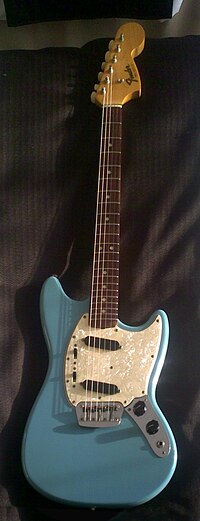Fender Duo-Sonic

Duo-Sonic II
|
|
| Manufacturer | Fender |
|---|---|
| Period | 1956–1969, 1993–1999, 2008–2011, 2016-Present |
| Body type | Solid |
| Neck joint | Bolt-on |
| Scale | 22.5" or 24" |
| Body | Ash, Alder or Basswood |
| Neck | Maple |
| Fretboard | Maple or Rosewood |
| Bridge | fixed |
| Pickup(s) | 2 "vintage style" single coil |
| Desert Sand, Sunburst (sometimes called maroonburst), Sonic Blue, Dakota Red, Black, Torino Red, Arctic White | |
The Fender Duo-Sonic guitar was launched by Fender as a "student" model guitar. The "Duo-Sonic" features two single-coil pick-ups and a vertical (as opposed to Fender's standard blade-style) switch on the lower horn of the body to select bridge, neck or both pickups in a humbucking style configuration. The Duo-Sonic features typical Fender construction techniques with a bolt-on maple neck, attached to a solid body. The bridge is fixed and the line has a shorter scale neck than standard models as a concession to younger, beginner guitarists and other players with smaller hands.
The Fender Duo-Sonic was introduced in 1956. Like the Musicmaster introduced a few months earlier, it featured basic but effective construction and a 22.5 inch scale length (standard Fender guitars feature a 25.5 inch scale) and cost $149.50. The original model was only available in a light tan color called Desert Sand and had a maple fingerboard with 21 frets and a neck with a soft-V profile. The original model Duo-Sonics also sport a gold-colored, anodized pickguard that helps in screening the single-coil pickups and electronics from interference.
In 1959 the Duo-Sonic went through a face lift. The most significant change was a switch from a maple fingerboard to a rosewood one in keeping with changes to other Fender models at this time. These fretboards were originally in the slab-style but switched to the veneer style after approximately a year. The other significant change was a switch from anodized aluminum to plastic pickguards.
In 1964 the Duo-Sonic was redesigned based on the Fender Mustang that had recently been added to the student model line but without the vibrato tail-piece. The student guitars now all featured larger and slightly offset bodies, necks with larger headstocks and rosewood fingerboards and plastic pickguards with the volume and tone controls mounted on a separate metal plate. Pickup selection was moved above the pickups on both the Duo-Sonic and the Mustang and utilized two 3-position on-off-on switches that allowed for in and out-of-phase sounds. The pickups were also reverse-wound/reverse-polarity, which made them into a functional humbucker when both pickups were used simultaneously. Also added in this redesign was the option of a 24 inch scale neck in addition to the 22.5 inch scale. This re-designed model was renamed Duo-Sonic II although decals with and without the II designation were used occasionally. In addition to white, Daphne Blue and Dakota Red colors added.
...
Wikipedia
